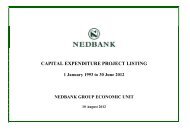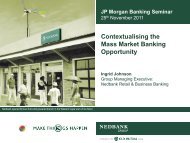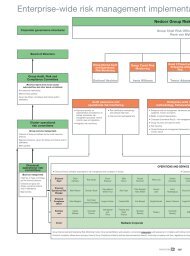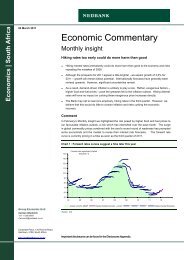NEDBANK CAPITAl - Nedbank Group Limited
NEDBANK CAPITAl - Nedbank Group Limited
NEDBANK CAPITAl - Nedbank Group Limited
- No tags were found...
You also want an ePaper? Increase the reach of your titles
YUMPU automatically turns print PDFs into web optimized ePapers that Google loves.
isk and BALANCE SHEET management reportIndividual risk appetite targets, as relevant to the approved business activities, have been approved and cascaded down from grouplevel for each business cluster, major business unit and the monolines in <strong>Nedbank</strong> Retail.One of the risk appetite metrics that we are currently in excess of due to the retail asset classes and the current economicenvironment, and which is in line with our peer group, is the group’s target credit loss ratio range, details of which may be found onpage 145. We currently expect to remain outside the target range in 2010, but addressing this is a key component of the2010 – 2012 business plans. The reversals of provisions in the balance sheet is expected to take longer as defaulted advancescontinue to increase, albeit at a slower rate. The group remains cautious about impairments.In conclusion, <strong>Nedbank</strong> <strong>Group</strong> has a strong risk culture and a conservative risk appetite, which is well-formalised, managed andmonitored on an ongoing basis, bearing the board’s ultimate approval and oversight.Overview of the Internal Capital Adequacy Assessment ProcessIn line with the four key principles contained in Pillar 2 of Basel II, the SA regulations relating to banks set out in regulation 39the Internal Capital Adequacy Assessment Process (ICAAP) requirements of banks and related Supervisory Review and EvaluationProcess (SREP) requirements of the SA Reserve Bank (SARB). A summary of this is depicted below.In addition, SARB have provided further guidance on the 12 ICAAP principles.Summary of the ICAAP and SREP requirementsICAAP Principle 1Every bank shouldhave an ICAAPICAAP Principle 2Ultimate responsibilityfor a bank’sICAAP is the boardICAAP Principle 3Written recordof ICAAPRequirements of the banksICAAP.Principle 1• Banks to have an ICAAP within which itsstrategy is to be linked with risk appetiteand capital levels.Requirements of the regulatorSREP.Principle 2• Regulators to review and evaluate bank’s ICAAP.• Regulators able to take action if not satisfiedwith a bank’s ICAAP.ICAAP Principle 7ICAAP to beforward-lookingICAAP Principle 8ICAAP to be riskbasedICAAP Principle 9Importance of stresstesting and scenarioanalysisICAAP Principle 4ICAAP to be anintegral part ofmanagement anddecisionmakingculture of a bankICAAP Principle 5Proportionality tosize and complexityof operationsICAAP Principle 6Regularindependent reviewof ICAAPPrinciple 3• Banks expected to hold capital in excess ofthe regulatory minimum.• Regulators with power to enforce.Board andmanagementoversightComprehensiverisk assessmentand management(to address ALLmaterial risks)Main ICAAP componentsIntegrated capitalassessment andmanagementPrinciple 4• Regulators to intervene early to preventcapital falling below required minimumlevels.Monitoring andreportingInternal controlreviewICAAP Principle 10Diversification andconcentration risk tobe well-consideredICAAP Principle 11Credit concentrationrisk to bewell-consideredICAAP Principle 12Adequacy andintegrity of ICAAPmodelsICAAP is primarily concerned with <strong>Nedbank</strong> <strong>Group</strong>’s comprehensive approach, assessment, coverage and management of risk andcapital from an internal perspective, that is over and above the minimum regulatory rules and capital requirements of Basel II.ICAAPs have first been completed in South Africa in 2008, are approved by the board and then submitted to SARB for review.136<strong>NEDBANK</strong> GROUP ANNUAL REPORT 2009

















